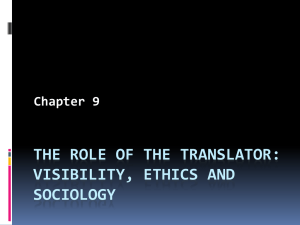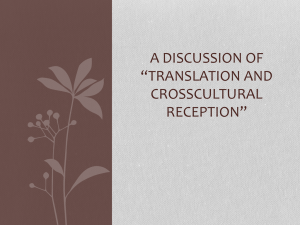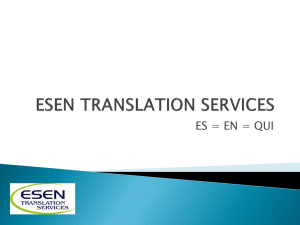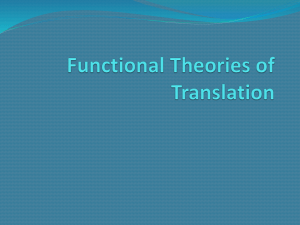Legal translation and translator training
advertisement
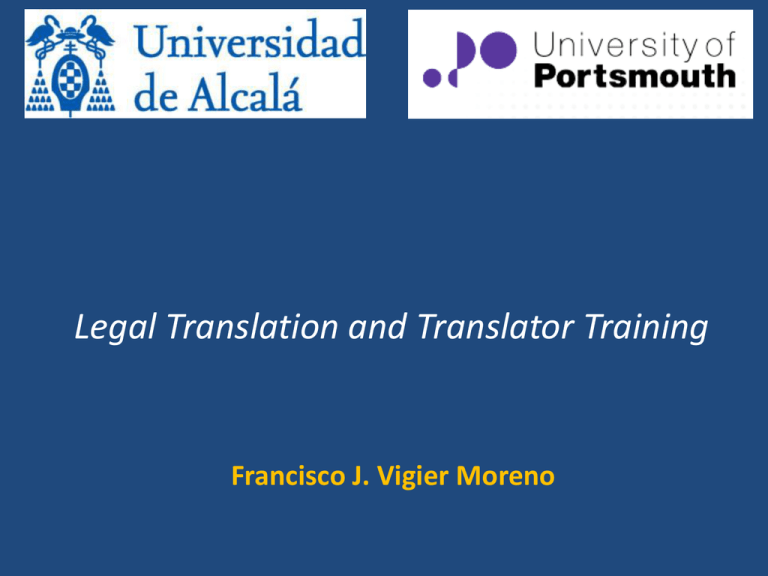
Legal Translation and Translator Training Francisco J. Vigier Moreno Contents Legal Translation Legal texts Legal translation as a profession Legal Translator Training Legal translator competence My experience in training legal translators 2 Legal Translation and Translator Training • Legal translation translation of legal texts • What is a legal text? 1. A text dealing with legal concepts? A very extensive text typology 2. A text involved in legal proceedings? A very extensive text typology 3 Legal Translation and Translator Training • What is a legal text? (2) 3. A text orginated from a legal (communicative) situation? A very extensive text typology 4. A specialised text pertaining to the legal field? 4 Legal Translation and Translator Training • Legal text – It is difficult to give a definition – It comprises many different situations and actors – There is an overlap with related fields (administrative texts, commercial texts, financial texts, institutional texts…) interdisciplinary nature of law and legal translation 5 Legal Translation and Translator Training – Prototypical legal texts (legal terminology and phraseology) • Legislative texts • Judicial texts • Law reports • Deeds and wills • Contracts • Administrative texts • Research papers (on legal matters) • Textbooks… 6 Legal Translation and Translator Training • How to translate legal texts? – Specialised field (previous expert knowledge required) – Legal discourse (technical, but also obscure, archaic, ambiguous…) – Legal asymmetry / cultural anisomorphism (different legal systems and cultures) – Lack of conceptual and terminological equivalence, especially in those terms related to procedures, institutions and personell 7 Legal Translation and Translator Training 8 Legal Translation and Translator Training 9 Legal Translation and Translator Training 10 Legal Translation and Translator Training Legal translation profession • Ever increasing activity as a result of globalisation – In-house translators at international organisations and bodies (e.g. EU and UN) – In-house translators at translation agencies – Freelancers (working for companies and individuals) – In-house staff of international law firms, businesses, agencies, NGOs… with duties including internal translations – In many countries, state-certified official translators (In Spain, Traductor-Intérprete Jurado; no British counterpart) 11 Legal Translation and Translator Training • Common problems faced by a legal translator – Responsibility and deontology – Lack of recognition – Lack of resources (for certain language pairs) – Unrealistic deadlines – Illegibility of originals 12 Legal Translation and Translator Training 13 Legal Translation and Translator Training Translator Competence • Consensus as to competence-based translator training (Hurtado 2007) • Training programmes are orientated towards the development of translator competence • Consensus as to translator competence as a macrocompetence including the skills, abilities, knowledge, aptitudes and attitudes which must be attained in order to carry out a translation task successfully to a professional standard 14 Legal Translation and Translator Training • Kelly (2002) – Communicative and textual competence – Cultural and intercultural competence – Thematic competence – Instrumental and professional competence – Psychophysiological competence – Interpersonal competence All of them governed by strategic competence 15 Legal Translation and Translator Training • Kelly (2002) – Communicative and textual competence – Cultural and intercultural competence – Thematic competence – Instrumental and professional competence – Psychophysiological competence – Interpersonal competence All of them governed by strategic competence 16 Legal Translation and Translator Training • EMT (2009) – Translation service provision competence (interpersonal and production dimensions) – Language competence – Intercultural competence (sociolinguistic and textual dimensions) – Information mining competence – Thematic competence – Technological competence 17 Legal Translation and Translator Training • EMT (2009) – Translation service provision competence (interpersonal and production dimensions) – Language competence – Intercultural competence (sociolinguistic and textual dimensions) – Information mining competence – Thematic competence – Technological competence 18 Legal Translation and Translator Training Legal translation competence (Prieto 2011) – Strategic or methodological competence (which controls the application of the other competences) • Analysis of translation briefs, contextualisation and general work planning • Identification of problems and implementation of translation procedures • Self-assessment and quality control – Communicative and textual competence • Linguistic, sociolinguistic and pragmatic knowledge • Knowledge of legal language uses and legal genre conventions – Thematic and cultural competence • Knowledge of legal systems, legal sources and branches of law • Awareness of asymmetry between legal notions and structures – Instrumental competence • Specialised resources, information and terminology management • Use of parallel documents – Interpersonal and professional management competence 19 Legal Translation and Translator Training Legal translation competence (Prieto 2011) – Strategic or methodological competence (which controls the application of the other competences) • Analysis of translation briefs, contextualisation and general work planning • Identification of problems and implementation of translation procedures • Self-assessment and quality control – Communicative and textual competence • Linguistic, sociolinguistic and pragmatic knowledge • Knowledge of legal language uses and legal genre conventions – Thematic and cultural competence • Knowledge of legal systems, legal sources and branches of law • Awareness of asymmetry between legal notions and structures – Instrumental competence • Specialised resources, information and terminology management • Use of parallel documents – Interpersonal and professional management competence 20 Legal Translation and Translator Training Legal translation competence (Prieto 2011) – Communicative and textual competence • Knowledge of legal language uses and legal genre conventions – Classification of legal genres – Comparative legal linguistics (features of legal discourse in source and target languages and jurisdictions) – Thematic and cultural competence • Knowledge of legal systems, legal sources and branches of law • Awareness of asymmetry between legal notions and structures – Practical principles of comparative law (contrastive analysis of concepts in the legal systems) – Instrumental competence • Specialised resources, information and terminology management – Dictionaries, Terminological Databases, legislation, reference works, etc. 21 Legal Translation and Translator Training LEGAL TRANSLATION TRAINING PROGRAMMES Undergraduate (basic training) • Legal asymmetry • Basic legal knowledge and phraseology • Basic texts with legal contents (journal articles or administrative texts) • Identification of translation problems • Translation procedures to resolve those problems • Documentation skills applied to legal translation • Focus on the process rather than on the product 22 Legal Translation and Translator Training • Postgraduate (advanced training) – Equip students with the skills required in the job market • Greater emphasis on legal asymmetry • In-depth legal knowledge and phraseology • Documents representative of professional practice (as wide a range as possible) • Justification of translation solutions (with a reference to reliable sources) • Research resources • Focus on the product rather than on the process 23 Legal Translation and Translator Training Recommendations in legal translation • Contextualise the translation task Analysis of the translation brief Analysis of the ST and TT Contrastive study between the source legal system and the target legal system Collection and analysis of parallel texts (especially TT) 24 Legal Translation and Translator Training "Even if legal translators do not need to be equipped with a jurist’s level of legal expertise, it is essential that they acquire sufficient legal knowledge in order to situate the documents in their legal and procedural context, as well as to grasp the legal effects of original and target texts. In fact, legal translation between national systems normally entails an exercise of comparative law before any translation procedure can be applied to culturally-marked segments on reasoned grounds (…) The deeper the knowledge of legal subjects, the more confident the translator can feel when dealing with legal content issues during analysis and transfer stages of translation" (Prieto 2011: 13) 25 Legal Translation and Translator Training Research/Documentation plan • Thematic documentation Acquire knowledge related to the specific field Understand the ST Sources: reference works, handbooks, encyclopaedias, specialised journals, specialised monolingual and bilingual dictionaries… • Terminological documentation Identify specialised terms in the ST and understand their meaning Find an equivalent term in the TL Sources: databases, glossaries, dictionaries… • Cotextual and contextual documentation (parallel texts) Identify both the macrostructure and microstructure of ST and TT Sources: more problematic (authentic/private documents) 26 Legal Translation and Translator Training Recommendations in legal translation • Be faithful to the original text (equivalence in terms of meaning, style and discourse) • Avoid abusing literal solutions, not only lexical (false friends) but also syntactical and stylistic calques, and opt for other translation procedures which prove adequate given the context, genre conventions and communicative purpose – Adaptation delito de guante blanco (white glove crime ) white collar crime – Amplification magistrado (magistrate ) senior judge / judge of a high court – Generalisation magistrado (magistrate ) judge – Modulation / Transposition en su opinión… he held that… demora en la entrega late delivery 27 Legal Translation and Translator Training • Future prospects – Ever increasing activity – Focus on the accreditation/training of legal translators and on the quality of legal translations 28 Legal Translation and Translator Training • Future prospects – DIRECTIVE 2010/64/EU on the right to interpretation and translation in criminal proceedings 29 Legal Translation and Translator Training • Future prospects – DIRECTIVE 2010/64/EU on the right to interpretation and translation in criminal proceedings 30 Legal Translation and Translator Training • Future prospects – DIRECTIVE 2010/64/EU on the right to interpretation and translation in criminal proceedings 31 Legal Translation and Translator Training – QUALETRA project (2012-2015) • Improving the training of legal translators • Assessing the quality of legal translations • Monitoring legal translators’ work conditions • Developing an accreditation system for legal translators Partnership including 9 EU universities, ECBA, CCBE and EULITA 32 Legal Translation and Translator Training 33 Legal Translation and Translator Training • REFERENCES HURTADO ALBIR, Amparo (2007) Competence-based Curricula Design for Training Translators. The Interpreter and Translator Trainer 1 (2): 163-195. KELLY, Dorothy (2002) Un modelo de competencia traductora: Bases para el diseño curricular. Puentes 1: 9-20. EMT Expert Group (2009) Competences for professional translators, experts in multilingual and multimedia communication. Brussels: European Commission. PRIETO RAMOS, Fernando (2011) Developing Legal Translation Competence: an Integrative Process-oriented Approach. Comparative Legilinguistics International Journal for Legal Communication 5: 7-21. 34 Thank you for your attention Francisco J. Vigier Moreno francisco.vigier@uah.es

